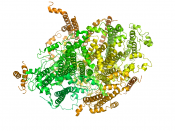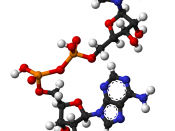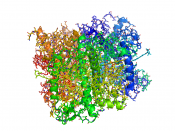There are two different light reaction cycles that occur in the thylakoid membrane within the chloroplast. The first, and most complex cycle is the non-cyclic. It begins with an H20 molecule splitting into 2H+ and ý O2 in the process of photolysis. (During photolysis oxygen is released as a byproduct.) The two electrons lost from H20 are transferred to chlorophyll 680. Different pigments in Photosystem II can absorb specific wavelengths of light. The energy from light causes the electrons to become charged and move from P680 to the Primary Acceptor.
The Primary Acceptor is the first rung on the electron transport chain. As the charged electrons move down the chain they lose energy. This energy is used to synthesize ATP.
After the electrons have lost their energy they move onto Photosystem I. There they are charged by energy from sunlight via chlorophyll P700 and sent to another Primary Acceptor. This Primary Acceptor is part of another Electron Transfer Chain.
The electrons now move down this chain and produce another energy rich molecule, NADPH.
The other light reaction is cyclic photophosphorylation. This cycle is much shorter and less complex. It's only purpose is to produce ATP. Both of these cycles products are synthesized for the use of the Calvin-Benson cycle, which produces glucose, the main energy storing molecule for cells. As the Calvin-Benson cycle uses much more ATP than it does NADPH the light reactions must conform to that need.
The cyclic photosphorylation begins with Photosystem I. From this photosystem electrons move to a Primary Acceptor. The Primary Acceptor then sends the electrons to a chemical, ferredoxin. From ferredoxin they move to the Cytochrome complex. Between the Cytochrome complex and plastocynin energy for chemiosmotic synthesis of ATP is released. The electrons then cycles back to Photosystem I and repeats until a...


